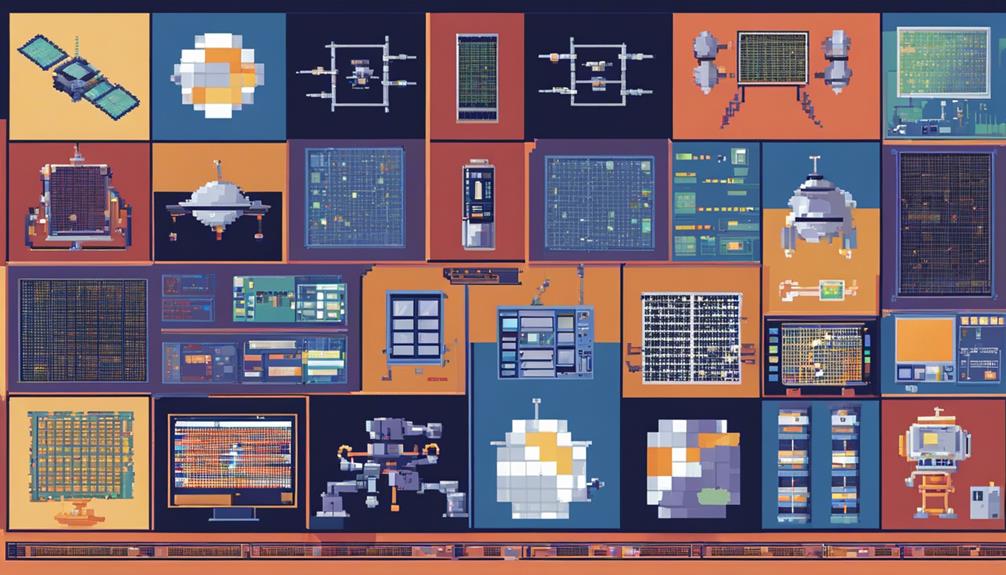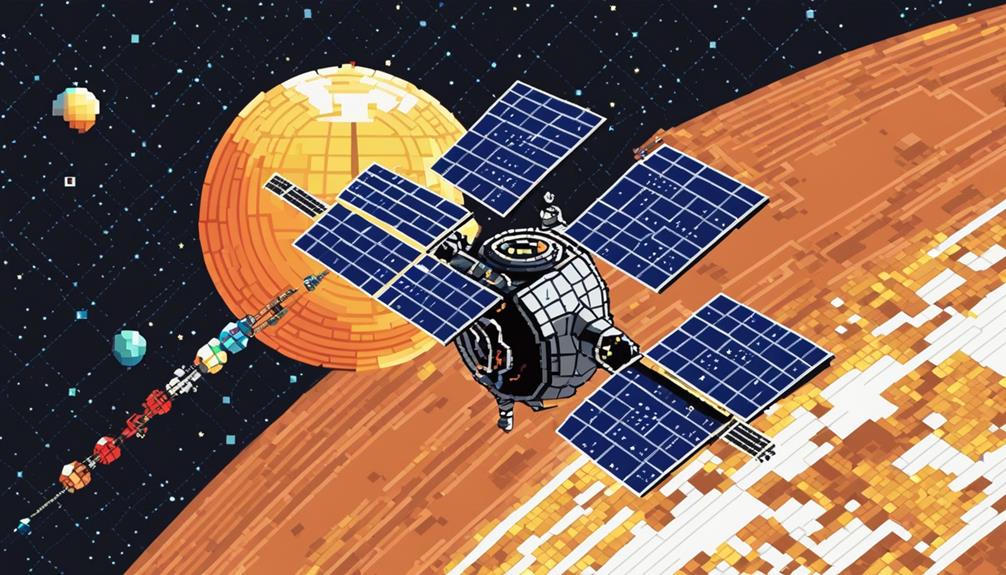The intricate web of communication systems embedded within satellites is the lifeblood of modern space missions, ensuring seamless transmission of data and commands essential for spacecraft operations. From the meticulous orchestration of frequency bands to the sophisticated interplay between ground and space segments, every element is meticulously designed to navigate the vast expanse of outer space. The evolution towards higher frequency bands like Ka-band opens up new frontiers for satellite communications, promising enhanced data capabilities and driving innovation in the realm of space technology.
Key Takeaways
- Frequency band selection crucial for signal optimization.
- System architecture enhances data transmission efficiency.
- Satellite design factors impact signal quality and coverage.
- Regulations govern power management, encryption, and global connectivity.
Radio Frequency Communications

Radio Frequency communications are a critical component of spacecraft communication systems, encompassing transmitters, channels, and receivers for signal transmission. In the realm of spacecraft communication, NASA predominantly utilizes S-band, X-band, and Ka-band frequencies. Each band serves specific functions: S-band is commonly used for telemetry and command operations, X-band excels in data transmission, while Ka-band facilitates high-speed data transfer.
While higher frequency bands like X-band and Ka-band offer superior data rates and bandwidth, they come with challenges such as rain fade, which can disrupt communication signals. Despite these challenges, these bands are essential for enabling the transmission of large volumes of data at high speeds, particularly for missions requiring substantial data transfer capabilities.
The significance of RF communication systems in spacecraft cannot be understated, as they have played a pivotal role in the success of various missions, including Mars rovers and deep space probes. The ability to transmit crucial telemetry data and receive commands from Earth is foundational to the functionality and operation of spacecraft in various missions, showcasing the indispensable nature of RF communication systems in the realm of space exploration.
Free Space Optical Communications
Utilizing laser technology for data transmission through free space, Free Space Optical Communications (FSO) offer enhanced data rates and heightened security compared to conventional RF systems. FSO systems use laser transmitters to send data across open space to receivers, enabling high-speed communication between satellites or between a satellite and a ground station.
| Key Aspect | Description |
|---|---|
| Data Rates | FSO provides higher data rates compared to RF systems, enhancing throughput. |
| Security | FSO offers increased security due to the focused nature of the laser beam. |
| Atmospheric Interference | FSO faces challenges from atmospheric conditions affecting signal quality. |
| Alignment | Precise alignment between transmitter and receiver is crucial for FSO links. |
However, FSO systems do encounter obstacles such as atmospheric interference, which can degrade signal quality, beam divergence over long distances, and the need for precise alignment between transmitter and receiver. To mitigate these challenges, FSO commonly utilizes near-infrared bands for better transmission through the atmosphere. The hardware components of an FSO system include laser transmitters, receivers, and mechanisms for accurate pointing to maintain a stable connection. By addressing these technical aspects, FSO continues to be a promising technology for secure and high-speed satellite communications.
Frequency Bands

Drawing attention to the varying frequency bands crucial in satellite communication systems, the allocation of specific bands plays a fundamental role in optimizing signal quality and data transmission efficiency for diverse applications and industries. Satellite communication utilizes different frequency bands such as L-band, C-band, S-band, Ku-band, and Ka-band, each offering unique characteristics suited for specific purposes. The L-band, operating between 1-2 GHz, is commonly employed in mobile applications due to its penetration capabilities in various atmospheric conditions. In contrast, the Ka-band, ranging from 27-40 GHz, is favored for high-bandwidth services requiring fast data transmission speeds.
Higher frequency bands like Ka-band enable enhanced data transmission rates, making them ideal for applications demanding rapid information exchange. Moreover, these bands support the use of smaller ground equipment, contributing to increased efficiency in satellite communications. While C-band provides broad coverage with lower transmission power, Ku-band offers more focused coverage with higher power levels. The selection of the appropriate frequency band is critical for ensuring optimal signal quality, data rates, and coverage based on specific communication requirements and environmental factors in satellite communication systems. By leveraging the unique characteristics of each frequency band, satellite communication networks can deliver reliable and efficient services across various industries.
System Architecture
The system architecture of satellite communication plays a crucial role in facilitating signal transmission and data reception. By integrating transmitters, channels, and receivers, satellite communication systems ensure efficient communication between satellites and ground stations. This architecture enables functionalities such as uplink, downlink, and crosslink communications, forming the backbone of satellite-based communication networks.
Signal Transmission
Signal transmission in satellite communication systems involves the exchange of data between ground stations and satellites through a carefully orchestrated process of uplink, transponder processing, and downlink stages. This system architecture enables efficient two-way communication for data exchange between satellites and Earth. The signal follows a specific path through the communication system components to ensure seamless data relay. The uplink transmission originates from ground stations, reaching the satellites for processing by the transponder. Subsequently, the processed signal is transmitted back to designated ground stations through the downlink stage. This structured approach guarantees the effective transfer of information in satellite communication networks.
- Uplink transmission from ground stations
- Signal processing by the satellite transponder
- Downlink transmission to designated ground stations
- Specific path through communication system components
- Seamless data relay
Data Reception
Data reception in satellite communication systems is a critical component that involves ground stations receiving signals from satellites through downlink transmissions and processing the data for various applications. Ground stations utilize antennas to capture these signals, which are then fed into receiving equipment for further processing. To ensure the accuracy of data reception, tracking telemetry and control (TT&C) systems are employed at ground stations. The received data undergoes processing and decoding to extract valuable information such as images, videos, telemetry, or commands transmitted from the satellites. Efficient data reception is paramount for maintaining seamless communication between satellites and ground stations across a wide array of applications.
| Data Reception Components | Description |
|---|---|
| Antennas | Capture signals from satellites |
| Receiving Equipment | Processes incoming data |
| TT&C Systems | Ensure accurate data reception |
| Processing and Decoding | Extracts information from data |
Major Components in Communication Systems

Key elements within communication systems in satellites encompass antennas, transponders, and specialized signal processing units facilitating efficient data transmission.
- Antennas: Crucial for receiving and transmitting signals in different frequency bands between the satellite and ground stations.
- Transponders: Amplify, convert, and retransmit signals to ensure effective communication over long distances.
- Signal Processing Units: Assist in encoding, decoding, and modulating data for transmission, ensuring efficient communication between satellites and Earth.
- Amplification: Transponders boost signal strength to maintain communication integrity over vast distances.
- Signal Conversion: Transponders convert signals from one frequency to another for efficient communication links.
These components play a vital role in establishing robust communication channels between satellites and ground stations. Antennas act as the interface for signal exchange, while transponders ensure signals are appropriately amplified and relayed to their destinations. Signal processing units are the brains of the operation, handling data encoding, decoding, and modulation to guarantee accurate and reliable communication. The synergy between antennas, transponders, and signal processing units enables seamless data transmission, supporting a wide array of satellite missions and applications that rely on uninterrupted and efficient communication links.
Design Considerations
When designing communication systems for satellites, critical considerations such as antenna placement and power consumption play a pivotal role in achieving optimal performance. Antenna placement determines the satellite's ability to transmit and receive signals efficiently, impacting overall communication effectiveness. Additionally, managing power consumption is essential to ensure continuous operation and longevity of the satellite in orbit.
Antenna Placement
Strategically positioning antennas on satellites is a critical aspect of optimizing signal reception and transmission efficiency. When considering antenna placement, several design considerations come into play to ensure optimal performance:
- Minimization of interference to enhance signal clarity.
- Maximization of coverage to reach a broader audience.
- Alignment with ground stations for effective communication.
- Accounting for spacecraft structure to avoid physical obstructions.
- Adhering to power constraints to ensure efficient energy usage.
Proper antenna placement not only improves communication reliability but also enhances data transfer efficiency within satellite systems. By carefully addressing these factors, satellite operators can establish robust and efficient communication links while maximizing the overall performance of their satellite networks.
Power Consumption
Efficient management of power consumption is a critical aspect of satellite communication system design, aiming to optimize operational longevity and performance. Satellite communication systems utilize power-efficient components such as solar panels and advanced batteries to minimize overall power usage. Additionally, thermal regulation systems are crucial in maintaining optimal operating temperatures to prevent power wastage. Propulsion systems are optimized for efficiency, reducing power consumption during orbital adjustments. Monitoring and control systems, including Tracking, Telemetry, and Control (TT&C), play a pivotal role in managing power usage in satellites. By integrating these power-saving technologies and strategies, satellite communication systems can effectively enhance their operational lifespan and performance while ensuring reliable communication in space environments.
Policies and Licensing

Satellite communication systems are subject to stringent policies and licensing requirements that govern spectrum allocation and ensure adherence to international standards. Licensing is essential to manage the proper use of frequency bands and guarantee compliance with regulations. Here are five key points regarding policies and licensing in satellite communications:
- Regulatory Bodies: Satellite operators must secure licenses from regulatory bodies such as the FCC in the United States to operate legally and provide services to customers.
- International Standards: Licensing processes involve coordination with national and international telecommunications authorities to align with global standards and regulations.
- Spectrum Allocation: Spectrum management policies play a crucial role in satellite communications by preventing interference and promoting efficient use of radio frequencies.
- Compliance: Licensing ensures that satellite operators adhere to rules and guidelines set forth by regulatory bodies to maintain a fair and competitive market.
- Efficiency: Effective licensing processes contribute to the efficient operation of satellite communication systems, enhancing connectivity and reliability for users worldwide.
Encryption
Encryption technology plays a pivotal role in ensuring the confidentiality and integrity of data transmitted through satellite communication systems. By encoding information, encryption ensures that data remains secure during transmission, preventing unauthorized access. Advanced Encryption Standard (AES) is widely adopted in satellite communication systems for its robust protection of sensitive information. Encryption keys serve as the foundation for decrypting encoded data, emphasizing the critical need for secure key management to uphold communication security.
In satellite systems, the implementation of secure communication protocols such as Secure Sockets Layer (SSL) and Transport Layer Security (TLS) further enhances data protection by safeguarding both the integrity and confidentiality of transmitted information. These protocols establish encrypted links between devices, ensuring that data remains secure against interception and tampering.
As cybersecurity threats continue to evolve, encryption technology in satellites undergoes constant refinement to address emerging challenges. This ongoing development aims to fortify data protection measures in satellite communication systems, mitigating risks posed by cyber threats and ensuring the resilience of data transmission processes against unauthorized access or manipulation. By staying at the forefront of encryption advancements, satellite communication systems can adapt to emerging threats and uphold the security standards necessary for reliable data transmission.
Antennas

In the realm of satellite communication systems, antennas serve as critical components responsible for receiving and transmitting radio frequency signals to establish communication links with ground stations. Antennas on satellites play a crucial role in ensuring the successful exchange of data and information between the satellite and the ground stations. Here are some key points regarding antennas in satellite communication:
- Satellite antennas come in various types such as parabolic, helical, and phased array antennas, each serving different communication needs.
- Phased array antennas, in particular, enable electronic beam steering without the need for physical movement, enhancing flexibility in communication.
- Satellite antennas must be designed to withstand harsh space environments, including radiation exposure and temperature fluctuations, to ensure reliable operation.
- The size and design of antennas directly impact signal strength, data rates, and coverage area of satellite communication systems.
- Proper antenna selection and positioning are crucial factors in optimizing communication performance and ensuring effective coverage in different geographical areas.
Efficient antenna systems are essential in maximizing the effectiveness of satellite communication, especially in challenging space environments where reliable and high-quality communication links are paramount.
Frequently Asked Questions
What Are the 3 Types of Satellite Communication?
The three types of satellite communication are one-way simplex, two-way half duplex, and two-way full duplex systems. Simplex allows data flow in one direction, like TV broadcasting. Half duplex permits communication in both directions but not simultaneously, found in satellite phones. Full duplex supports simultaneous two-way communication, common in internet connections via satellites. Each type serves various applications like global coverage, military uses, commercial services, remote sensing, internet connectivity, weather forecasting, and emergency response.
What Are the 5 Forms of Communications Transmitted From Satellites?
In the realm of satellite communications, data is transmitted through various means. Signal strength, data transfer, frequency bands, and modulation techniques play pivotal roles in this intricate process. Orbital mechanics, antenna technology, satellite networks, ground stations, and satellite tracking collectively ensure efficient communication. Satellite coverage spans vast areas, enabling widespread connectivity. These elements converge to form a robust system that facilitates diverse forms of communication via satellites.
How Do They Communicate With Satellites?
Ground stations communicate with satellites through uplink signals in specific frequency bands. Data transfer occurs via antenna systems on both ends. Signal modulation techniques ensure efficient communication. Orbit tracking and link budgets are crucial for maintaining the connection. Doppler effect correction, error correction coding, and beamforming technology optimize signal quality. This comprehensive approach enables reliable two-way communication for command execution and data retrieval.
What Type of Communication Is Satellite Communication?
Satellite communication is a form of wireless communication that relies on the transmission of signals between ground stations and satellites orbiting the Earth. It utilizes various frequency bands to facilitate data transmission through different modulation techniques. Satellite networks employ different orbit types and antenna designs to establish reliable connections. Link budgets are carefully calculated to optimize signal strength and minimize interference, ensuring efficient communication between ground stations and satellites.
